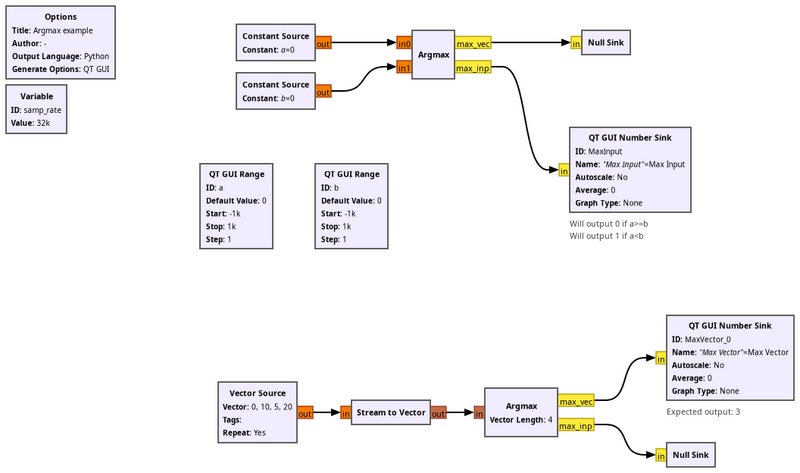Argmax: Difference between revisions
Jump to navigation
Jump to search
| Line 23: | Line 23: | ||
== Example Flowgraph == | == Example Flowgraph == | ||
This flowgraph shows the two usecases of the Argmax block. | |||
The top case shows how the max_inp output works. | |||
The bottom case shows how the max_vec output works. | |||
[[File:Argmax.png|800px]] | |||
<p>This flowgraph can be downloaded from [[Media:Argmax.grc]].</p> | |||
== Source Files == | == Source Files == | ||
Revision as of 10:36, 15 April 2025
Compares vectors from multiple streams and determines the index in the vector and stream number where the maximum value occurred.
Data is passed in as a vector of length vlen from multiple input sources. The block analyzes the input streams of data items and outputs two streams:
- max_vec: Stream 0 will contain the index value in the vector where the maximum value occurred. This output is of short data type.
- max_inp: Stream 1 will contain the number of the input stream that held the maximum value. This output is of short data type.
Parameters
- IO Type
- Supported data types
- Float
- Int
- Short
- Num Inputs
- Number of input streams to include in the operation
- Vec Length
- Length of the vector
Example Flowgraph
This flowgraph shows the two usecases of the Argmax block.
The top case shows how the max_inp output works.
The bottom case shows how the max_vec output works.

This flowgraph can be downloaded from Media:Argmax.grc.
Source Files
- C++ files
- argmax_impl.cc
- Header files
- argmax_impl.h
- Public header files
- argmax.h
- Block definition
- blocks_argmax_xx.block.yml